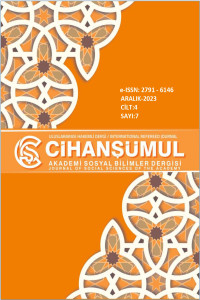ESRA YILDIZ, THE HISTORY OF THE BUILDINGS OF SHAYKH AL-ISLAM OFFICE IN THE LIGHT OF THE DOCUMENTS OF THE MESHIHAT ARCHİVES (1826-1924), ANKARA: İLAHİYAT PUBLISHING, 299 P, ISBN 978-625-8031-49-2.
Abstract
In recent years, the number of academic studies on the institution and history of Shaykh al-Islam has been increasing. One of these studies is titled "The History of the Buildings of Shaykh al-Islam Office in the Light of the Documents of the Meshihat Archives (1826-1924)" written by Dr. Esra Yıldız. The Ottoman Empire needed an institution for the execution of religious transactions as it entered the process of institutionalization from the moment it appeared on the stage of history. In order to answer the questions of the people on religious issues, it organized the office of Shaykh al-Islam, which it inherited from the Islamic states before it, and turned it into an institution. Bureaucracy, one of the main phenomena of Ottoman modernization, was effective in the institutionalization of the office of Shaykh al-Islam by becoming an institution. The process of the Shaykh al-Islam office becoming an institution and taking its place within the bureaucratic organization started with the Tanzimat and continued with the abolition of the Janissary Quarry and the allocation of an independent place for the Shaykh al-Islam office. The office of Shaykh al-Islam completed its institutionalization by renewing its units, establishing independent units, or transferring pre-existing units to the Bab al-Meshihat. In the study, which was prepared with a rich academic literature by using basic sources such as archive books and documents, especially the archive of the office of Shaykh al-Islam, the subjects were handled in a concise manner, and the history of the office of Shaykh al-Islam and the buildings of the office of Shaykh al-Islam were examined from an academic perspective in various aspects.
ESRA YILDIZ, MEŞİHAT ARŞİVİ BELGELERİ IŞIĞINDA ŞEYHÜLİSLAMLIK BİNALARININ TARİHÇESİ (1826-1924), ANKARA: İLAHİYAT YAYINLARI, 2022, 299 S, ISBN 978-625-8031-49-2.
Abstract
Son yıllarda Şeyhülislâmlık Müessesine ve tarihçesine dair yapılan akademik çalışmaların sayısı giderek artmaktadır. Bu çalışmalardan biri de. Dr. Esra Yıldız’ın kaleme almış olduğu “Meşihat Arşivi Belgeleri Işığında Şeyhülislâmlık Binalarının Tarihçesi (1826-1924)” başlıklı çalışmasıdır.
Osmanlı Devleti, tarih sahnesinde varlık gösterdiği andan itibaren kurumsallaşma sürecine girmesiyle birlikte dini işlemlerin yürütülmesi için bir müesseseye ihtiyaç duymuştur. Halkın dini konulardaki sorularına cevap bulmak amacıyla kendisinden önceki İslam devletlerinden tevarüs ettiği Şeyhülislâmlığı, teşkilatlandırarak bir müessese haline getirmiştir. Osmanlı modernleşmesinin temel olgularından biri olan bürokrasinin Şeyhülislâmlığın bir müessese haline gelerek kendi içerisinde kurumsallaşmasında etkili olduğu görülmüştür. Şeyhülislâmlığın bir müessese haline gelerek bürokratik teşkilat içerisinde yerini alması süreci, Tanzimat ile başlamış Yeniçeri Ocağının kaldırılması ve Şeyhülislâmlığa müstakil bir yer tahsisi ile devam etmiştir. Şeyhülislâmlık, bünyesindeki birimleri yenileme, müstakil birimler kurma veya önceden var olan birimleri Bâb-ı Meşîhat’e nakletmek suretiyle kurumsallaşmasını tamamlamıştır.
Alanında konuyla ilgili Şeyhülislamlık Arşivi başta olmak üzere, Arşiv Defter ve Belgeleri gibi temel kaynaklar kullanılarak zengin bir akademik literatürle hazırlanmış olan çalışmada; konular özlü bir şekilde ele alınmış, Şeyhülislamlık ve Şeyhülislamlık binalarının tarihçesi çeşitli yönleriyle akademik bir perspektiften incelenmiştir.
Details
| Primary Language | Turkish |
|---|---|
| Subjects | Ottoman Central Organization |
| Journal Section | Kitap İncelemesi |
| Authors | |
| Early Pub Date | December 31, 2023 |
| Publication Date | December 31, 2023 |
| Submission Date | November 13, 2023 |
| Acceptance Date | December 18, 2023 |
| Published in Issue | Year 2023 Volume: 4 Issue: 7 |
Cihansumul Academy Journal of Social Sciences is licensed under a Creative Commons Attribution-NonCommercial 4.0 International License (CC BY NC).


